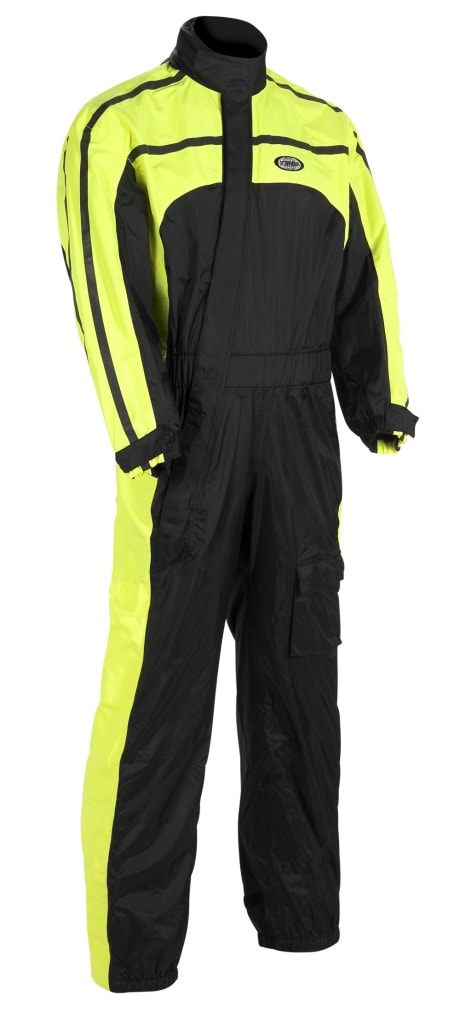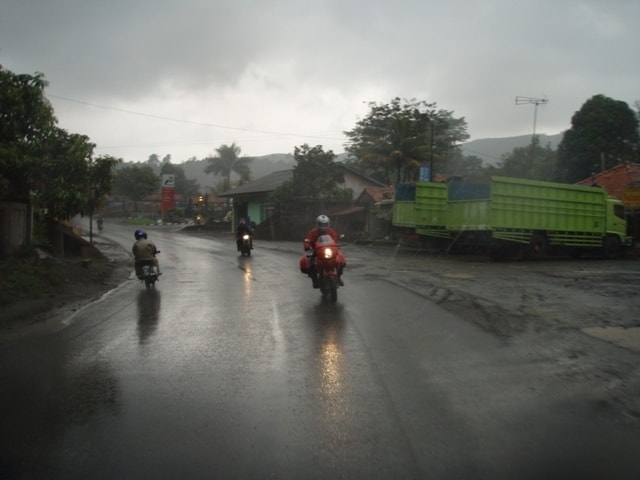Regardless if you ride your bike day by day or just during the weekend, at some moment you will be caught in the rain. That is why most riders get used to rain riding by accident, but it’s better to know some basic rules when it happens. Although many articles on riding in the rain will not recommend to change your style of riding, you should be a bit more careful.
Every beginner thinks about rain riding with fear, avoiding as much as possible his/hers first encounter with the slippery roads. But this is not an exclusive beginner problem. Those who have been riding through rain already, know how it is, but still try to avoid it. There are multiple reasons for this rain riding phobia reported by riders, such as getting wet, hard vision or slippery roads, all of which are quite understandable.
We cannot make it disappear or make you enjoy it, but at least we can give you a couple of tips to help get along with the rainy situations.
A Good Rain Gear
Rain, like crashing, isn’t so bad if you are dressed for it. A Gore-Tex two-piece suit is comfortable, easy to put on and most of all will keep you dry. If you want some warmth, you can also choose a one-piece suit. Get waterproof gloves and boots to complete the gear.
If you want the inside of gloves to stay dry longer, then you have to put the gauntlets under the cuffs of your rain suit or jacket. This keeps water from running down into the cuffs. A full-face helmet is indicated, but don’t forget to change the dark faceshield with a clear one or to take off the sunglasses.
Once you have a feel for traction, you should have some idea of how much you can safely ask the tires to deliver under braking and cornering. A slight increase in tire pressure also improves the wet-weather traction of any tire. Increasing your tire pressure by five psi or less helps to cut through the film of water and prevent hydroplaning.
Since during the rain surfaces are slicker than usual, brakes are less effective, so it will take you much longer to stop than when you are riding on dry roads. Begin with slowing down and keep the throttle neutral. Initiate turns a bit more gradually. Downshift smoothly, engaging the clutch a bit slower than usual, and avoid abrupt throttle changes. Get on the throttle progressively. Anticipation can help you use more efficiently the engine brake inputs in preparation for turning or intersections. The engine break reduces the potential sideslips and blocking the wheels.
As for your own ability to see, wear a helmet with a clear faceshield, and treat it with an anti-fogging solution. But be careful. You can ruin it by using chemicals designed for glass only, so you should read the label first. Don’t wipe the visor with your hand while riding!
If you want the inside of gloves to stay dry longer, then you have to put the gauntlets under the cuffs of your rain suit or jacket. This keeps water from running down into the cuffs. A full-face helmet is indicated, but don’t forget to change the dark faceshield with a clear one or to take off the sunglasses.
Traction
Traction seems to be the primary concern for most riders, usually because they aren't sure how much grip they have available. The easiest way to test traction is to see the limits of your rear brake. Assuming you know how much deceleration you can develop on dry pavement before the rear tire breaks loose, you have a gauge of what's available if you repeat the test when the road is wet.Once you have a feel for traction, you should have some idea of how much you can safely ask the tires to deliver under braking and cornering. A slight increase in tire pressure also improves the wet-weather traction of any tire. Increasing your tire pressure by five psi or less helps to cut through the film of water and prevent hydroplaning.
Body Positioning
First of all, relax. It’s not a solution to stay stiff like just waiting for anything to happen. All you have to do is stay relaxed, focused, but also ready for everything. Face the direction you want to go with your chest. Keep your legs on the pegs, and to make it clear, the toes on the tip of the peg, while the heels are up and pushing on the heel guard of rear-sets.Control and Technique
You have to focus on the speed and direction changes, as well as on braking and throttle. Let’s take it one step at a time, which is exactly how you should take it when you are riding on rain. In other words, accelerate after you make a turn or downshift before you start to turn. It is better not to combine actions on your tires, because less tension on the tires means a better traction.Since during the rain surfaces are slicker than usual, brakes are less effective, so it will take you much longer to stop than when you are riding on dry roads. Begin with slowing down and keep the throttle neutral. Initiate turns a bit more gradually. Downshift smoothly, engaging the clutch a bit slower than usual, and avoid abrupt throttle changes. Get on the throttle progressively. Anticipation can help you use more efficiently the engine brake inputs in preparation for turning or intersections. The engine break reduces the potential sideslips and blocking the wheels.
Vision
If other drivers have difficulties seeing you when the weather is nice, imagine that it’s getting worse during the rain. It’s better to avoid wearing a black gear or a neutral color like gray and try thinking of a bright yellow rainsuit. Fluorescent colors are the best and if the suit also has a retro-reflective striping or panels, helmet or backpack is even better. And don’t forget to turn on your lights. That is for being seen. Not much, but it makes a difference.As for your own ability to see, wear a helmet with a clear faceshield, and treat it with an anti-fogging solution. But be careful. You can ruin it by using chemicals designed for glass only, so you should read the label first. Don’t wipe the visor with your hand while riding!

